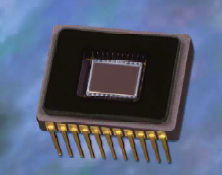SBIG History
![]() News
News ![]() Products
Products ![]() Pricing
Pricing ![]() Distribution
Distribution ![]() Notes & Interesting Articles
Notes & Interesting Articles
The AllSky-340 and AllSky-340C
Simple and Highly Capable Wide Sky Coverage CCD Cameras
On 5 February 2009 Company Seven announced two new SBIG AllSky cameras, their third generation that will replace their predecessors. The new AllSky-340 and AllSky-340C began shipping from Company Seven in August 2009, we even acquired one AllSky-340C for ourselves! You may order the monochrome or color version of these AllSky3 series system now with fisheye lens, or without lens.
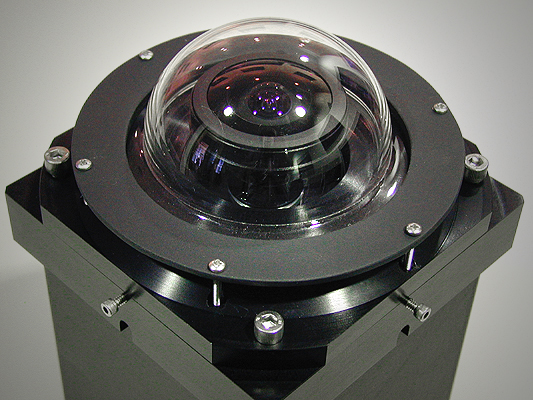
Right: Prototype SBIG AllSky-340 series camera in its weatherproof housing.
This will be SBIG's third version of a weatherproof AllSky camera for monitoring weather conditions. The first had to be obsoleted when SBIG stopped production of the , and the second went obsolete when the lens then being used became unavailable and with no suitable replacement. With each version developed SBIG gain some new insight and knowledge and this AllSky series is the best one yet. The AllSky model 340 is a monochrome camera while the model 340C uses a color CCD. The imaging sensor is the Kodak KAI-0340 CCD with 640 x 480 pixels, each is 7.4 micron square, and a high gain output stage for excellent sensitivity. The camera electronics and CCD are from the soon to be released SBIG Smart Guider camera, a new autonomous guide camera. The AllSky series cameras will precede the new guider since the software development task was easier and has essentially been completed at this point.
This AllSky camera incorporates the SBIG Smart Guider CCD Camera inside an aluminum enclosure with an acrylic dome to protect the fisheye lens. The fisheye objective is Fujinon's new model FE185C046HA-1, a 1.4 mm focal length F/1.4 lens. We have tested this lens and the image quality is excellent wide open, all the way to the horizon.
 Among the numerous challenges of an AllSky camera are that the moon can appear in the field of view literally for half of the time, averaged over a month. The reflections from within the dome and the lens can interfere with the detection of stars and other celestial phenomena.
Among the numerous challenges of an AllSky camera are that the moon can appear in the field of view literally for half of the time, averaged over a month. The reflections from within the dome and the lens can interfere with the detection of stars and other celestial phenomena.
Figure 1 Right: 'Fisheye' view taken through the SBIG AllSky-340 camera.
The exposure time was 60 seconds, and this image was acquired from a light polluted backyard as the first quarter moon had just set behind the roof. Also note the Milky Way showing across the sky.
 Figure 2 is an image taken earlier in the night, with the dome in place, that has been DDP scaled to show the stars and the sky close to the moon. Some ghost reflections are visible, but the image quality overall is excellent.
Figure 2 is an image taken earlier in the night, with the dome in place, that has been DDP scaled to show the stars and the sky close to the moon. Some ghost reflections are visible, but the image quality overall is excellent.
Figure 2 Right: image taken earlier in the night with First Quarter Moon off axis in field of view.
By actual test of an RS-232 link using a USB to RS-232 adapter running at 460.8 Kbaud, with a 100 foot cable, downloads a full image happen reliably in 15 seconds. At 115.2 Kbaud a full image takes 60 seconds. Bluetooth wireless adapters will typically run at 115 K-baud, and the one we have tried here worked reliably at a distance of 75 feet. With wireless links one must minimize the number of walls you have to pass through. Each wall (two layers of dry wall or wood) costs about a factor of two signal and range.
These may seem rather long download times compared to the USB 2.0 interface of our last AllSky camera, but the new AllSky-340 can take an image while transmitting, so with exposures longer than the download time the camera is only insensitive for the length of the readout of the CCD, which takes place in less than 1 second to an internal memory buffer within the camera. As a result, the camera is excellent for meteor detection. Its field of view is wider than our previous meteor camera, so it should see many more meteors near the horizon. One other plus the software can run continuously in the background while you use your computer for other tasks.
At these slow download rates the computer workload is so slight your applications won't even notice. It will not interfere with regular imaging using the same PC. The AllSky image is there when you want to view it.
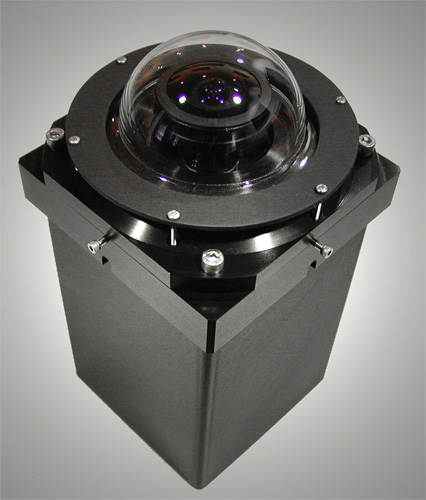 The fisheye lens is mounted to a plate which can be translated, tipped, and focused relative to the CCD. So the full resolution of the lens can be achieved. This plate is also heated to keep the lens free of condensation. The heat rises into the acrylic dome, warming it and keeping off the dew, and drying off raindrops. The inexpensive acrylic dome is easily replaced by removing a few screws allowing for routine replacement in the field as the dome suffers the inevitable scratches and damage due to sunlight, windblown dust and disrespectful birds. Company Seven will maintain a supply of replacement domes on short order.
The fisheye lens is mounted to a plate which can be translated, tipped, and focused relative to the CCD. So the full resolution of the lens can be achieved. This plate is also heated to keep the lens free of condensation. The heat rises into the acrylic dome, warming it and keeping off the dew, and drying off raindrops. The inexpensive acrylic dome is easily replaced by removing a few screws allowing for routine replacement in the field as the dome suffers the inevitable scratches and damage due to sunlight, windblown dust and disrespectful birds. Company Seven will maintain a supply of replacement domes on short order.
Figure 3 Right: Weatherproof AllSky Camera Housing.
The prototype camera shown here is black however, the production versions have a white body section so the system does not get too hot in the sun. The dimensions of this prototype are 5.5 x 5.5 x 11 inches (14 x 14 x 28 cm) but these are subject to change.
The lower housing contains the control panel with power and signal connectors for the camera. Furthermore, the housing is provided with four holes to facilitate bolting the assembly onto a post or mast.
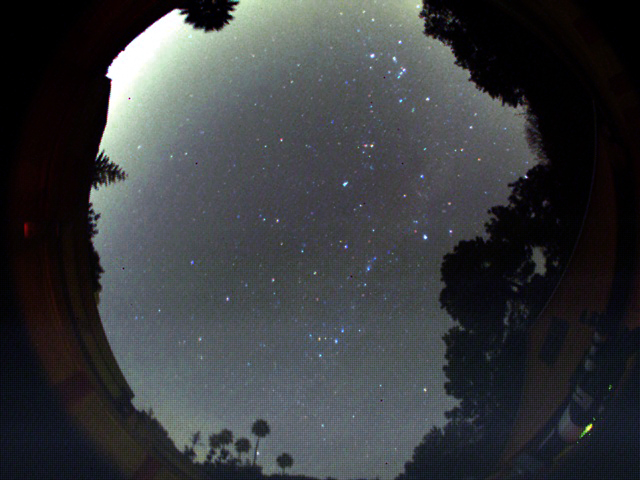 We also offer a color version of this product designated the AllSky-340C, this incorporates a KAI-340 CCD with a color matrix. This system too can produce dramatic images as shown in the accompanying Figure 4.
We also offer a color version of this product designated the AllSky-340C, this incorporates a KAI-340 CCD with a color matrix. This system too can produce dramatic images as shown in the accompanying Figure 4.
Figure 4 Right: AllSky-340C color camera image.
This camera can also take exposures as short as 50 microseconds so daylight operation is possible allowing recording of cloud conditions 24 hours a day. A blooming streak will be noted vertically through the sun, but otherwise the image is excellent.
Work in underway to modify the existing meteor camera software to support this new camera series. This will enable the detection and recording of bright meteors while you sleep. Iridium flares, space station overflights, and brighter satellites will also be captured along with the occasional "What is that?" We think the new AllSky camera will provide a very useful tool for the amateur with an automated or remotely controlled observatory setup trying to avoid clouds or adverse weather. Users interested in detecting and recording fireballs or those who simply wish to capture movies showing the beauty of the sky rotating endlessly over their heads can do this work with the AllSky camera. The software has the ability to capture and save movies in .avi format so that they may be transmitted and displayed afterwards. The file storage requirements are about 72 megabytes per day for 24 hours coverage, at a recording rate of one frame per minute.
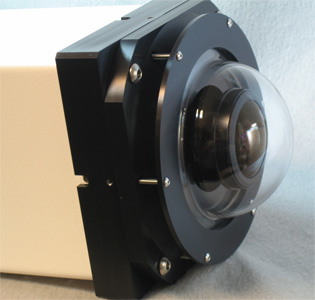
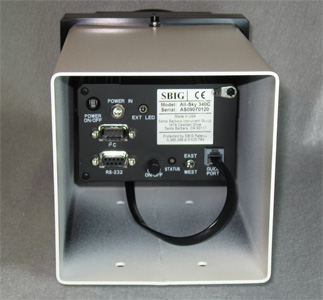
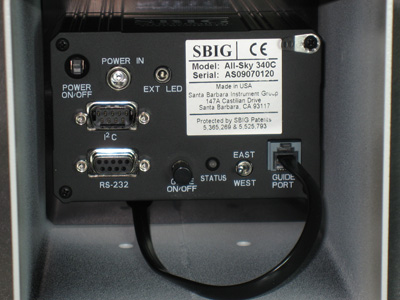
Above: views of production model AllSky-340C camera on display at Company Seven's showroom. |
Movie Files below we provide links to two sample movies taken by combining images from the AllSky-340. Your Web Browser must be enabled to allow popups and to view Audio Video Interleave (.avi) format files.
Please note these movies are compressed for web display and the level of compression affects the image quality. Uncompressed full frame images from the camera are posted above on this page for comparison. If you Windows Media Player does not play this movie you may need to download the DivX codec at http://www.divx.com/divx/windows/download/index.php
![]() AllSky camera view. This is in Audio Video Interleave (.avi) video and audio format and will play on most enabled browsers and video players.
AllSky camera view. This is in Audio Video Interleave (.avi) video and audio format and will play on most enabled browsers and video players.
AllSky-340C camera tests on the SBIG rooftop
This is a wireless AllSky roof-cam operating at the SBIG facility in California. As an experiment Matt Thomas set up a prototype of the AllSky camera on the roof at SBIG with a solar panel and battery for power, and with a Bluetooth adapter for downloading images. Matt wrote the software that collects the images as they come in then it converts these images and combines them into movies. To see the SBIG roof camera result files click here.
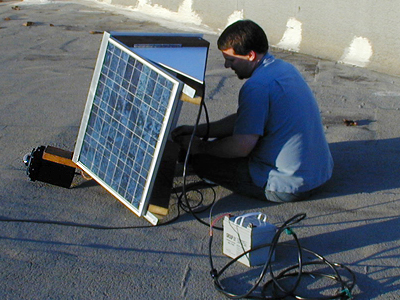 |
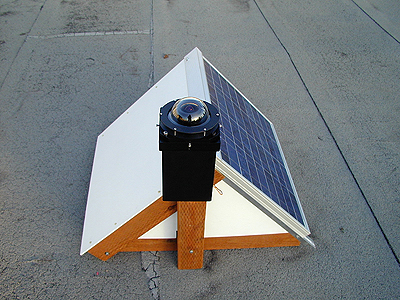 |
|
Above left: Matt Thomas setting up the solar panel dog house. |
Above Right: AllSky camera ready for action. |
Current Images From The SBIG Roof CameraBoth the DivX CODEC and Microsoft Windows Media Player are required to view the embedded video in the table below. If you would prefer to download the AVI files and view the movies in another player, then click here to bring up the files directory from the SBIG Server and download them at will.
|
|
|
|
|
Update Interval: minutes
The movies are split into multiple AVI files to keep the size of each file to a minimum. The .M3U files are the playlists that groups the AVI files into a single movie. This arrangement allows the movie to be viewed as the parts are downloaded, but also makes the first download a bit blocky (black, then video, then black, etc.). The times where nothing is shown are when the next AVI file is being downloaded. Once all the AVI files have loaded then the video repeats fairly smoothly - with only a minor blink when transitioning from one AVI file to the next. The All Sky Camera software lets you adjust the number of images in each AVI. The current setting is for the smallest AVI file - resulting in the most blinks during the playback.
